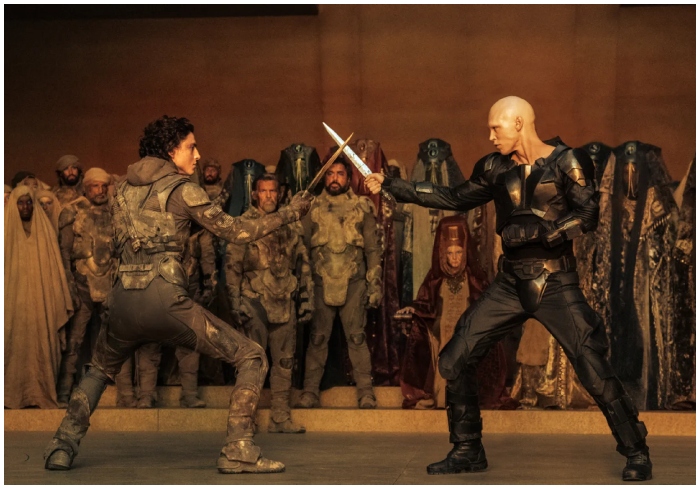Denis Villeneuve’s ambitious adaptation of Frank Herbert’s seminal sci-fi masterpiece, “Dune,” has been a topic of much debate and excitement among fans and critics alike. With the release of the second part of this vast adaptation, it’s worth exploring how Villeneuve’s interpretation aligns with Herbert’s original vision and where it diverges, creating a new landscape that’s both familiar and uncharted.
House Atreides
Villeneuve’s portrayal of House Atreides as a colonial power navigating the treacherous political landscape of the Galactic Imperium is spot on. The film adeptly explores the moral complexities and ambitions of the Atreides, avoiding the oversimplification of their role as mere saviors. This nuanced depiction resonates with Herbert’s intentions, highlighting the family’s quest for power while acknowledging their comparative righteousness amidst a galaxy of cutthroat politics.
The Fremen
One of the more contentious aspects of Villeneuve’s adaptation is the depiction of the Fremen. Herbert’s Dune is rich with references to Islamic culture and Arabic language, grounding the Fremen in a distinct cultural and religious identity that adds depth to their character and their struggle. Villeneuve’s choice to “de-Islamify” the Fremen, while perhaps aiming for universality, strips away a layer of complexity and uniqueness that was fundamental to Herbert’s portrayal. Engaging with Islamic scholars could have preserved this richness while respecting cultural sensitivities.
Arrakis
Villeneuve’s success in bringing the planet of Arrakis to life cannot be overstated. The immersive landscapes and the meticulous attention to the ecological and cultural details of this desert world capture the essence of Herbert’s Arrakis. This achievement creates a vivid backdrop that is essential for understanding the story’s dynamics and the significance of its setting.
Arrakeen
Contrastingly, the film’s representation of Arrakeen falls short of Herbert’s bustling capital. By keeping the city largely off-screen, the adaptation misses the opportunity to showcase the diversity of Fremen society and the vibrancy of interstellar commerce and intrigue that Herbert vividly describes. This choice inadvertently simplifies the Fremen, diminishing the rich tapestry of their community and culture.

Paul Muad’Dib
Villeneuve and Roth’s treatment of Paul Atreides as a complex figure destined for a role that is both revered and feared aligns perfectly with Herbert’s vision. The film captures the dangerous allure of a messianic figure, challenging the simplistic hero narrative and engaging with the profound implications of Paul’s rise to power. This approach honors the thematic depth of Herbert’s work, presenting a narrative that is as thought-provoking as it is thrilling.
Doctor Yueh
However, the adaptation’s handling of Doctor Yueh leaves much to be desired. Herbert’s Yueh is a tragic figure torn between his duty and his personal vendetta, a complexity that is lost in the film. This simplification robs the narrative of a poignant storyline, reducing a pivotal character to a mere plot device.
The Bene Gesserit
The portrayal of the Bene Gesserit in Villeneuve’s “Dune” stands out as a triumph. The film captures the secretive and manipulative nature of this all-female order with finesse, embracing the intricate web of religion and politics they weave. This adherence to Herbert’s depiction reinforces the Bene Gesserit’s critical role in the Dune universe and underscores the thematic richness of the source material.

Mentats and The Imperium
While the film brilliantly captures the oddity and complexity of the Imperium, its treatment of mentats falls short. The omission of key characters and the nuanced role of human computers in a universe wary of machines undercuts the depth of Herbert’s world-building. Similarly, the adaptation’s approach to the Spice and its cultural and hallucinogenic significance to the Fremen culture feels underdeveloped, missing an opportunity to explore one of the novel’s most fascinating aspects.
In conclusion, Denis Villeneuve’s adaptation of “Dune” is a visually stunning and thematically rich interpretation that succeeds in bringing Herbert’s universe to life in many ways. However, certain deviations from the source material, particularly in the portrayal of the Fremen and the depth of cultural references, suggest a missed opportunity to fully embrace the complexity of Herbert’s world. Despite these shortcomings, Villeneuve’s “Dune” stands as a significant cinematic achievement, offering a new lens through which to experience Herbert’s timeless saga.